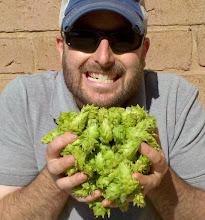Its been a while since I've brewed this style and I miss it! When I started brewing a number of years ago, everyone brewed pale ales and IPAs. In fact, a friend and I called hombrewer festivals "IPA Fests" since the dominant homebrew served was IPA. For years, pale ale seemed to be the only micro brew on tap and the flagship of every small brewery. Today, its more difficult to find craft pale ale that's good. In observation, the mainstream perception of "good beer" today is light styles such as wheat ales (though everyone likes to incorrectly call them hefeweizens) topped with a lemon, blondes, goldens, browns, and light lager. Along with those standards you'll see the less frequently poured beers such as amber and IPA. The logical step missing in many craft brew pubs is Pale Ale. In my opinion, Pale Ale is a gateway beer to bigger and more interesting styles. Another trend I've seen with pale ale is that its often beyond style. I've had some pale ales clearly more on the amber side or even more like an IPA. Mislabeling is always intentional for marketing to the masses. That's why many call their wheat ales, "Hefeweizen" and in one example here in San Diego, a kolsch is called a Pale Ale.
We have an upcoming Club Only Competition for Pale Ale giving a great excuse for me to return to this great beer style. My brother-in-law, Ed, came over with his brew equipment and some homebrew buddies and they cranked out two beers, an amber and a pale ale, all in the same time it took for me to brew my all-grain pale ale. I'm hoping that Ed also submits his pale ale to the COC and maybe to the next one as well since the focus will be brewing with extract.
As for the local homebrew, the California Common is in lagering and will remain there for about 3 more weeks. I will be sharing the milds with QUAFF during this Tuesday's club meeting. I tapped out the Agave Smoked Porter yesterday and luckily still have the two agave milds on tap. Last weekend we were in Utah and I was able to sample a number of good brews (more on that later).
American Pale Ale, February 20 2010
5 Gallons, All Grain, Single Infusion Step Recirculation Mash, 90 Minute Boil
4 lbs. Maris Otter Pale
4 lbs. Domestic 2-Row
1 lb. Vienna
1/2 lb. Munich
1/2 lb. Red Wheat Malt
1/2 lb. Victory (*slightly more than 1/2 lb.)
1/4 lb. Biscuit (*slightly less)
*I could use a digital scale!
1 oz. Homegrown Centennial hops for 60 min.
0.6 oz. Homegrown Centennial hops for 17 min.
1 Whirlfloc tab 15 min.
1/4 oz. Amarillo for 10 min.
1/4 oz. Cascade for 1 min.
1/4 oz. Perle for 1 min.
White Labs WLP001 California Ale Yeast (vial to starter)
OG: 1.062 @ 66°F
FG: 1.015 @ 42°F
Kegged on March 8th, ABV 6.4%
Bottled some on March 17th for sharing and the Club Only Competition
Our house is still fairly cold so fermentation temps will be very low (60-64°F) but I know that I can count on WLP001 to pull through.
UPDATE 2/28: WLP001 is still chugging along though the krausen has been falling slowly over the past couple of days. I should have put a thick blanket around the carboy during the initial ferment. I just checked the ambient temp of the carboy's location, 58°F.
UPDATE 3/20: Been sampling for a few days now, good brew but is a bit malty sweet. Next time, I'll wrap a blanket when the house is really cold. For me, the sweetness hides the complexity of the malt but the hop profile is what I was hoping for. On the other hand, this is a uniquely clean flavor profile for California Ale Yeast. I wonder if I could have just increased the pitch rate and still fermented at this temperature to achieve a lower final gravity and less residual sweetness. If so, this may be a golden ticket to chillindamos (happens to be better
than heaven).
UPDATE 3/25: I usually force carbonate at my standard pressure for about a week before tapping. Another week is often better. The CO2 volumes have increased. Also, maybe another week allowed some of the green qualities to dissipate. Either way, I can't have enough of this beer! Delishioso!








